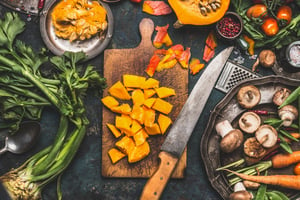 Fall is here and the holidays are just around the corner. Most American holiday traditions involve food, and fall and winter foods tend to be more calorie dense "comfort foods." We stuff ourselves during the fall while also being less active, staying indoors out of the cold. Then January 1st rolls around and we have to make a new year's resolution to get healthy again. It's a vicious (yet delicious) cycle, full of candy, pies, breads and smoked meats.
Fall is here and the holidays are just around the corner. Most American holiday traditions involve food, and fall and winter foods tend to be more calorie dense "comfort foods." We stuff ourselves during the fall while also being less active, staying indoors out of the cold. Then January 1st rolls around and we have to make a new year's resolution to get healthy again. It's a vicious (yet delicious) cycle, full of candy, pies, breads and smoked meats.
What can be done to avoid the classic fall weight gain? It's not as bad as you might think. Avoiding overeating and making some subtle changes to your holiday recipes can go a long way. Also, don't forget to stay active during the fall and winter. Find ways to get outside when the weather permits, bundle up and go for a walk, just keep moving! A more active lifestyle will keep your metabolism burning through some of those extra holiday treats. The website Livestrong.com provides us with some healthy eating tips to avoid fall weight gain.
Posted by: LIVESTRONG
How to Avoid Fall Weight Gain
In a 2000 study conducted by the National Institute of Child Health and Human Development and the National Institute of Diabetes and Digestive and Kidney Diseases, researchers looked at the weight and overall health of 195 men and women over the course of six months. On average, each persona gained 1.05 pounds between Thanksgiving and New Year's Day.
While one gained pound may seem insignificant, holiday pounds tend to stay, say the researchers, and increase your risk for serious conditions, such as high blood pressure, heart disease and diabetes. By starting your fall season off on a healthy foot (or plate), you improve your chance of dodging these risks. Doing so can also reduce emotional risks associated with overeating and weight gain, such as depressive moods, anxiety and intense sensations of shame.
Healthy Eating Lessons From History
"We should be adopting almost all of the Native American and pilgrim eating principles," Kress says. "Lean meats in the form of naturally-fed game, poultry and fresh-caught fish from pure streams and a clean ocean. Fresh fruits and vegetables. [There were] no bleached, enriched white flours or pastas, no fast-food joints, convenience stores or junk food. Those were the days."
While it isn't necessary, or perhaps realistic, to limit your fall foods to fresh-picked, organic fare, cutting back on processed foods and eating more natural, seasonal options adds ample bang to your nutritional buck.
The NICHHD and NIDDKD study of 2000 revealed only two contributing factors to holiday season weight gain: increased hunger and reduced physical activity. Following early Americans' lead by eating more grains, nuts, seeds, fruits and vegetables adds plentiful amounts of vitamins, minerals, antioxidants, healthy fats and fiber to your diet.
Because fiber promotes satiation, you'll experience less hunger between meals. Whole foods typically also require more chewing, which slows your eating pace and promotes portion and appetite control. And emphasizing nutritious food guards against food cravings, which can stem from nutrient deficiencies.
Carolyn Scott-Hamilton, a holistic nutritionist, natural-foods chef and creator of the Healthy Voyager brand, recommends pumpkins, sweet potatoes and yams as prime fall-friendly food choices.
"While folks tend to eat them at holiday meals or as fried snacks, such as sweet potato fries or chips, these veggies are incredibly versatile and should be incorporated regularly in fall meals in order to take advantage of their seasonal health benefits," Scott-Hamilton says. So make like the pilgrims and Native Americans and eat vegetables fresh or cooked from plates, not packages.
. . .
Although seasonal foods vary somewhat by region, fruits and vegetables particularly lush during autumn include:
- Apples
- Winter squash
- Pumpkin
- Broccoli
- Cauliflower
- Beets
- Parsnips
- Chard
- Eggplants
- Bell peppers
- Rutabagas
- Apricots
- Pears
- Grapes
- Apples
Here in Northern California, we have the luxury of access to all sorts of locally grown fruits and vegetables during most seasons. So find the nearest farmers market and find some healthy seasonal produce, while also supporting your local farmers. With the substitution of fresh fruits and vegetables for more calorie dense processed foods you will feel more full on fewer calories. Add a daily walk or some yard work to those diet changes and you just might head into the new year without those extra pounds.
It's always smart to get a checkup and assess your current health to establish a baseline so you can measure your progress. Visit the Medical Specialty Center – Your Everyday Health Care Clinic – at Orchard Hospital. Walk-ins are welcome. Open 7 days a week. It’s our goal to have fast and friendly care while delivering quality health care.
Our mission at Orchard Hospital is to provide our community with superior health care. We strive to ensure that your experience at Orchard Hospital is as pleasant and comfortable as possible. Our priority is to provide you with the care you need when you need it, with skill, compassion, and respect.



